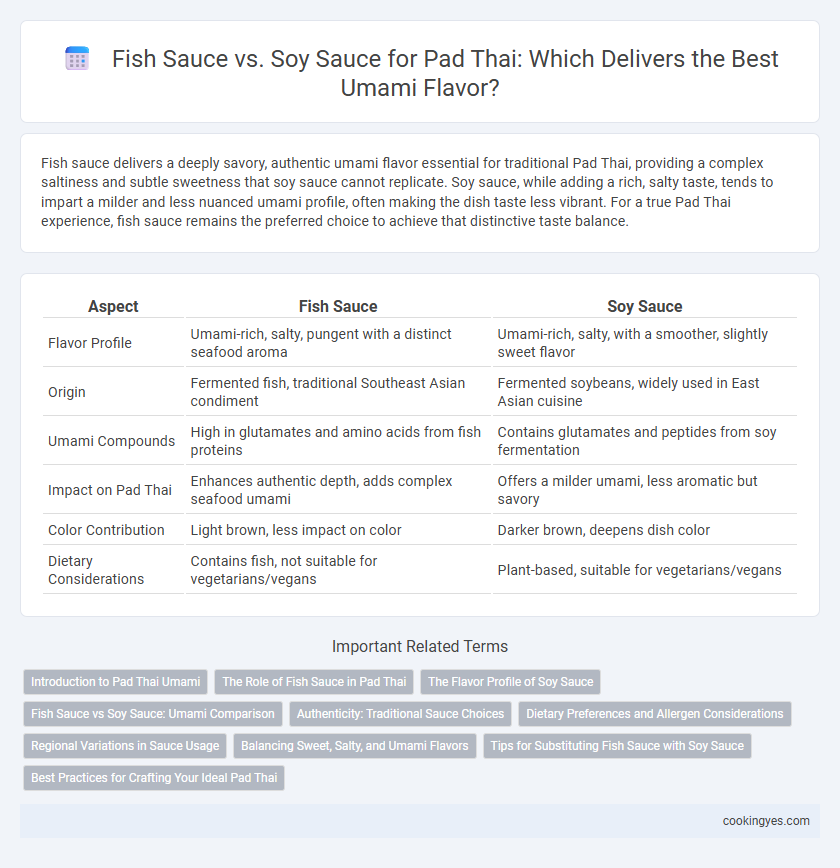Fish sauce delivers a deeply savory, authentic umami flavor essential for traditional Pad Thai, providing a complex saltiness and subtle sweetness that soy sauce cannot replicate. Soy sauce, while adding a rich, salty taste, tends to impart a milder and less nuanced umami profile, often making the dish taste less vibrant. For a true Pad Thai experience, fish sauce remains the preferred choice to achieve that distinctive taste balance.
Table of Comparison
| Aspect | Fish Sauce | Soy Sauce |
|---|---|---|
| Flavor Profile | Umami-rich, salty, pungent with a distinct seafood aroma | Umami-rich, salty, with a smoother, slightly sweet flavor |
| Origin | Fermented fish, traditional Southeast Asian condiment | Fermented soybeans, widely used in East Asian cuisine |
| Umami Compounds | High in glutamates and amino acids from fish proteins | Contains glutamates and peptides from soy fermentation |
| Impact on Pad Thai | Enhances authentic depth, adds complex seafood umami | Offers a milder umami, less aromatic but savory |
| Color Contribution | Light brown, less impact on color | Darker brown, deepens dish color |
| Dietary Considerations | Contains fish, not suitable for vegetarians/vegans | Plant-based, suitable for vegetarians/vegans |
Introduction to Pad Thai Umami
Fish sauce delivers a deeply savory umami flavor essential to authentic Pad Thai, contributing complex amino acids and a subtle marine tang. Soy sauce provides a milder, slightly sweet umami, often used as a vegetarian alternative but lacks the distinct depth of fish sauce. Combining fish sauce with tamarind and palm sugar creates the signature balance of salty, sweet, and tangy flavors that define traditional Pad Thai umami.
The Role of Fish Sauce in Pad Thai
Fish sauce is essential for authentic Pad Thai, providing a complex umami depth through its fermented anchovy base that soy sauce cannot replicate. Its salty, tangy flavor enhances the dish's savory profile while balancing sweetness and acidity. Using fish sauce preserves Pad Thai's traditional taste and aromatic richness, making it indispensable for genuine Thai flavor.
The Flavor Profile of Soy Sauce
Soy sauce imparts a rich, savory umami to Pad Thai through its fermented soybean base, delivering a balanced blend of salty and slightly sweet notes. Its complex flavor profile complements the dish's ingredients by enhancing depth without overpowering the subtle tamarind and lime acidity. Unlike fish sauce's intense brininess and marine essence, soy sauce offers a milder, earthier umami that appeals to those seeking a less pungent but equally flavorful alternative.
Fish Sauce vs Soy Sauce: Umami Comparison
Fish sauce delivers a stronger umami punch in Pad Thai due to its rich, fermented anchovy base, enhancing depth and authenticity in flavor. Soy sauce offers a milder, slightly sweeter umami, which can tone down the traditional savory profile of Pad Thai. For a more authentic and intense umami experience, fish sauce remains the preferred seasoning.
Authenticity: Traditional Sauce Choices
Fish sauce provides the essential umami depth and salty complexity central to authentic Pad Thai flavor, originating from the Thai culinary tradition where fermented fish paste is a staple. Soy sauce, while adding a savory note, lacks the distinct pungency and subtle sweetness that fish sauce contributes, making it a less traditional choice for genuine Pad Thai recipes. Using fish sauce preserves the traditional balance of sweet, sour, salty, and umami flavors that define classic Pad Thai authenticity.
Dietary Preferences and Allergen Considerations
Fish sauce delivers a robust, savory umami essential to traditional Pad Thai, but its anchovy content poses allergen risks and limits suitability for vegetarians and vegans. Soy sauce offers a plant-based umami alternative, rich in glutamates, making it ideal for gluten-free, vegetarian, or soy-tolerant diets when using tamari or refined versions. Selecting between fish sauce and soy sauce hinges on dietary preferences, allergen sensitivities, and the desired depth of authentic umami flavor.
Regional Variations in Sauce Usage
Fish sauce is traditionally favored in central Thailand for authentic Pad Thai, imparting a deep umami and salty complexity unique to the region. In southern Thailand, soy sauce variants, including sweet and dark soy sauces, are more commonly used, offering a milder, sweeter umami profile. These regional preferences highlight the diverse flavor landscapes in Thai cuisine, reflecting local ingredient availability and cultural tastes.
Balancing Sweet, Salty, and Umami Flavors
Fish sauce delivers a complex umami depth with its fermented anchovy base, providing a rich salty and savory profile essential for authentic Pad Thai flavor balance. Soy sauce contributes a milder, slightly sweet umami note that enhances sweetness while maintaining saltiness, making it ideal for a less pungent alternative. Combining both sauces allows precise control over the sweet, salty, and umami flavors, achieving the harmonious taste balance characteristic of traditional Pad Thai.
Tips for Substituting Fish Sauce with Soy Sauce
When substituting fish sauce with soy sauce in Pad Thai, use dark soy sauce to retain umami depth while adding a touch of sweetness and color enhancement. Incorporate a splash of seaweed broth or miso paste to mimic fish sauce's salty, fermented complexity and boost savory flavor. Adjust seasoning gradually to balance saltiness and preserve the authentic taste profile of traditional Pad Thai.
Best Practices for Crafting Your Ideal Pad Thai
Fish sauce delivers a complex umami depth with its rich, salty, and slightly fermented flavor, essential for authentic Pad Thai taste. Soy sauce offers a milder, sweeter umami profile, ideal for those seeking a less intense, vegetarian-friendly alternative. Combining fish sauce and soy sauce in balanced proportions enhances the dish's savory layers, creating the perfect harmony of traditional and adaptable flavors.
Fish sauce vs soy sauce for Pad Thai umami Infographic

 cookingyes.com
cookingyes.com